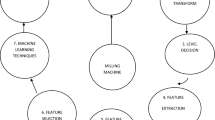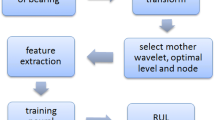Abstract
The paper aims to present the application of wavelet packet transformation for feature extraction from the signals acquired during friction stir welding of aluminum alloy. One of the challenges encountered while implementing wavelet packet transformation is the selection of an appropriate mother wavelet function. In this study, a new method is proposed for the selection of an appropriate mother wavelet function based on the ratio of energy of the signal to the entropy of the decomposed wavelet packets. Main spindle motor and feed motor current signals are acquired during 65 welding experiments designed through full factorial method by varying three process parameters in four levels. Features obtained from wavelet packet transformation along with process parameters are fed to two artificial neural network models: multi-layer feed-forward neural network model trained with back propagation algorithm and radial basis function neural network model for the prediction of ultimate tensile strength and yield strength of the welds. The prediction performance of the former model is found to be superior to the later model for both ultimate tensile strength and yield strength.
Similar content being viewed by others
References
Mishra RS, Ma ZY (2005) Friction stir welding and processing. Mater Sci Eng R 50:1–78
Boldsaikhan E, Corwin EM, Logar AM, Arbegast WJ (2011) The use of neural network and discrete Fourier transform for real-time evaluation of friction stir welding. Appl Soft Comput 11:4846–4893
Trummera VR, Suzano E, Beltrão M, Roos A, Santos JF, Castro PMST (2012) Influence of the FSW clamping force on the final distortion and residual stress field. Mater Sci Eng A 538:81–88
Yang Y, Kalya P, Landers RG, Krishnamurthy K (2008) Automatic gap detection in friction stir butt welding operations. Int J Mach Tools Manuf 48:1161–1169
Fleming PA, Lammlein DH, Wilkes DM, Fleming KA, Bloodworth TS, Cook GE, Strauss A, DeLapp D, Lienert T, Bement M, Prater T (2008) In-process gap detection in friction stir welding. Sens Rev 28(1):62–67
Cavaliere P, Campanile G, Panella F, Sqillace A (2006) Effect of welding parameters on mechanical and microstructural properties of AA6065 joints produced by friction stir welding. J Mater Process Technol 180:263–270
Trimble D, Monaghan J, Donnell GE (2012) Force generation during friction stir welding of AA2024-T3. CIRP Ann Manuf Technol 61:9–12
Das B, Pal S, Bag S (2016) A combined wavelet packet and Hilbert-Huang transform for defect detection and modelling of weld strength in friction stir welding process. J Manuf Process 22:260–268
Subramaniam S, Narayan S, Denis AS (2013) Acoustic emission-based monitoring approach for friction stir welding of aluminum alloy AA6063-T6 with different tool pin profiles. Proc IMechE Part B J Eng Manuf 227(3):407–416
Chen C, Kovacevic R, Jandgric D (2003) Wavelet transform analysis of acoustic emission in monitoring friction stir welding of 6061 aluminum. Int J Mach Tools Manuf 43:1383–1390
Zeng WM, HL W, Zhang J (2006) Effects of tool wear on microstructure, mechanical properties and acoustic emission of friction stir welding of 6061 aluminium alloy. ACTA Metall Sin (Engl Lett) 19:9–19
Pal S, Pal SK, Samantaray AK (2010) Prediction of the quality of pulsed metal inert gas welding using statistical parameters of arc signals in artificial neural network. Int J Comput Integr Manuf 23(5):453–465
Sick B (2002) On-line and indirect tool wear monitoring in turning with artificial neural networks: a review of more than a decade of research. Mech Syst Signal Process 16(4):487–546
Liu TI, Kumagai A, Wnag YC, Song SD, Fu Z, Lee J (2010) On-line monitoring of boring tools for control of boring operations. Robot Comput Integr Manuf 26:230–239
He K, Li X (2014) A quantitative estimation technique for welding quality using local mean decomposition and support vector machine. J Int Manag. doi:10.1007/s10845-014-0885-8.
Hunag PL, Li JF, Sun J, Jia XM (2016) Cutting signals analysis in milling titanium alloy thin-part components and non-thin wall components. Int. J. Adv. Manuf. Technol. (84):2461–2469.
He K, Li Q, Chen J (2013) An arc stability evaluation approach for SW AC SAW based on Lyapunov exponent of welding current. Measurement 46(1):272–278
He K, Zhang Z, Xiao S, Li X (2013) Feature extraction of AC square wave SAW arc characteristics using improved Hilbert-Huang transform and energy entropy. Measurement 46(4):1385–1392
Das B, Pal S, Bag S (2014) Monitoring of friction stir welding process through signals acquired during the welding. 5th International & 26th All India Manufacturing Technology, Design and Research Conference (AIMTDR 2014) December 12th–14th, 2014, IIT Guwahati, Assam, India.
Lakshminarayanan AK, Balasubramanian V (2009) Comparison of RSM with ANN in predicting tensile strength of friction stir welded AA7039 aluminium alloy joints. Trans Nonferrous Metals Soc China 19:9–18
Buffa G, Fratini L, Micari F (2012) Mechanical and microstructural properties prediction by artificial neural networks in FSW processes of dual phase titanium alloys. J Manuf Process 14:289–296
Shojaeefard MH, Behnagh RA, Akbari M, Givi MKB, Farhani F (2013) Modeling and Pareto optimization of mechanical properties of friction stir welded AA7075/AA5083 butt joints using neural network and particle swarm algorithm. Mater Des 44:190–198
Tansel IN, Demetgul M, Okuyucu H, Yapici A (2010) Optimizations of friction stir welding of aluminum alloy by using genetically optimized neural network. Int J Adv Manuf Technol 48:95–101
Dhanunjaya Y, Reddy A, Pratihar DK (2011) Neural network-based expert systems for predictions of temperature distributions in electron beam welding process. Int J Adv Manuf Technol 55:535–548
Roshan SB, Jooibari MB, Teimouri R, Ahmadi GA, Naghibi MF, Sohrabpoor H (2013) Optimization of friction stir welding process of AA7075 aluminum alloy to achieve desirable mechanical properties using ANFIS models and simulated annealing algorithm. Int J Adv Manuf Technol 69:1803–1818
Minton T, Mynors DJ (2006) Utilisation of engineering workshop equipment for friction stir welding. J Mater Process Technol 177(1–3):336–339
Arora KS, Pandey S, Schaper M, Kumar R (2010) Effect of process parameters on friction stir welding of aluminum alloy 2219-T87. Int J Adv Manuf Technol 50:941–952
Moataz MA, Salem HG (2005) Friction stir welding parameters: a tool for controlling abnormal grain growth during subsequent heat treatment. Mater Sci Eng A 391:51–59
Mao Y, Ke L, Liu F, Huang C, Chen Y, Liu Q (2015) Effect of welding parameters on microstructure and mechanical properties of friction stir welded joints of 2060 aluminum lithium alloy. Int J Adv Manuf Technol. doi:10.1007/s00170-015-7191-2
Sakthivel T, Sengar GS, Mukhopadhyay J (2009) Effect of welding speed on microstructure and mechanical properties of friction-stir-welded aluminum. Int J Adv Manuf Technol 43:468–473
Pal S, Heyns PS, Freyer BH, Theron NJ, Pal SK (2011) Tool wear monitoring and selection of optimum cutting conditions with progressive tool wear effect and input uncertainties. J Intell Manuf 22(4):491–504
Ngui WK, Leong MS, Hee LM, Abdelrhman AM (2013) Wavelet analysis: mother wavelet selection methods. Appl Mech Mater 393:953–958
Li X (1998) Real-time detection of breakage of small diameter drills with wavelet transform. Int J Adv Manuf Technol 14:539–543
Kwak JS (2006) Application of wavelet transform technique to detect tool failure in turning operations. Int J Adv Manuf Technol 28:1078–1083
Hua W, Guanlong C, Ping Z, Zhongqin L (2006) Periodic trend detection from CMM data based on the continuous wavelet transform. Int J Adv Manuf Technol 27:733–737
Ao Y, Qiao G (2010) Prognostics for drilling process with wavelet packet decomposition. Int J Adv Manuf Technol 50:47–52
Kwak JS, Ha MK (2004) Detection of dressing time using the grinding force signal based on the discrete wavelet decomposition. Int J Adv Manuf Technol 23:87–92
Yu G, Li C, Kamarthi S (2009) Machine fault diagnosis using cluster-based wavelet feature extraction and probabilistic neural network. Int J Adv Manuf Technol 42:145–151
Chen X, Li B (2007) Acoustic emission method for tool condition monitoring based on wavelet analysis. Int J Adv Manuf Technol 33:968–976
Abu-Zahra NH, Lange JH (2002) Tool chatter monitoring in turning operations using wavelet analysis of ultrasound waves. Int J Adv Manuf Technol 20:248–254
Humberstone M, Wood B, Henkel J, Hines JW (2012) Differentiating between expanded and fault conditions using principal component analysis. J Intell Manuf 23:179–188
Haykin S (2003) Neural networks: a comprehensive foundation. Pearson Education, Delhi
Taghi M, Baghmisheh V, Pavesic N (2004) Training RBF networks with selective backpropagation. Neurocomputing 62:39–64
Author information
Authors and Affiliations
Corresponding author
Rights and permissions
About this article
Cite this article
Das, B., Pal, S. & Bag, S. Weld quality prediction in friction stir welding using wavelet analysis. Int J Adv Manuf Technol 89, 711–725 (2017). https://doi.org/10.1007/s00170-016-9140-0
Received:
Accepted:
Published:
Issue Date:
DOI: https://doi.org/10.1007/s00170-016-9140-0




